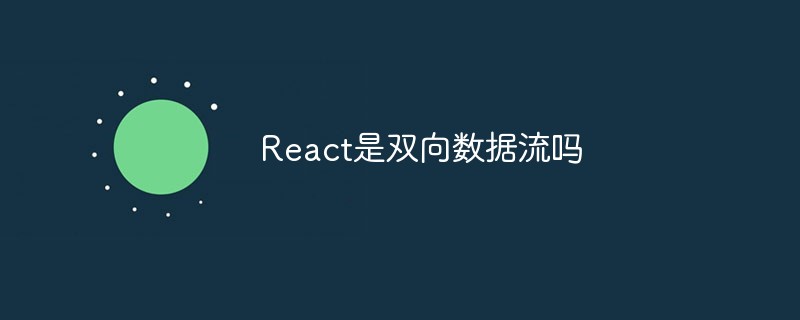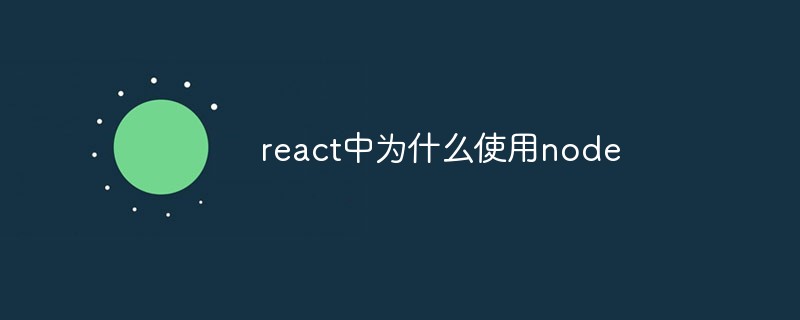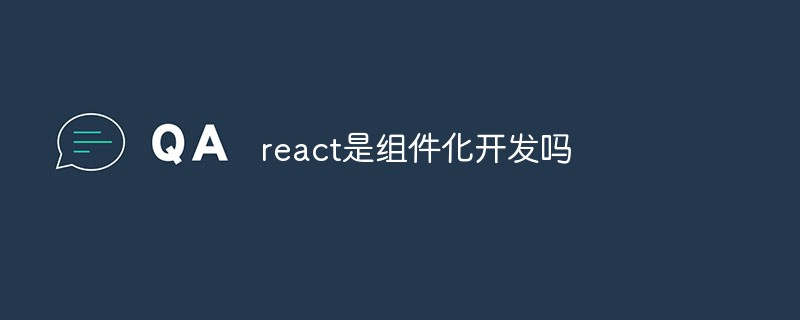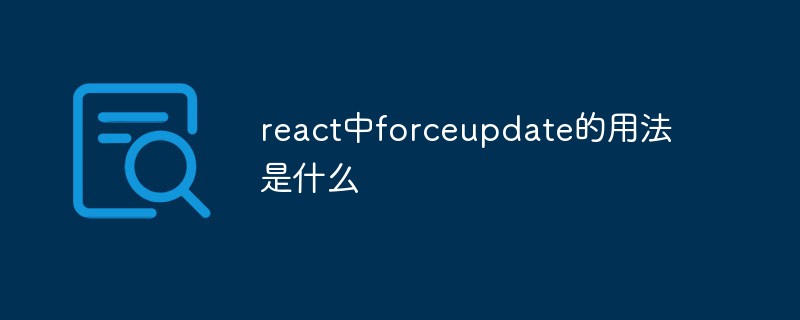The life cycle of React is divided into initialization phase, update and destruction phase. Initialization represents the first rendering of the component in the DOM tree, update represents the process of re-rendering the component; destruction represents the process of deleting the component from the DOM
React is a JavaScript library used to build user interfaces. It is mainly used For building UI, it has high performance and the code logic is very simple. What I will introduce today is the life cycle of React, which has a certain reference effect and I hope it will be helpful to everyone.

【Recommended course: react tutorial】
The react life cycle is divided into three stages: initialization stage, update stage, and destruction stage. Next, in the article, I will introduce you in detail
Initialization phase:
That is, the component is rendered in the DOM tree for the first time
import React, { Component } from 'react';
class Test extends Component {
constructor(props) {
super(props);
}
}The initialization phase is the same as the construction method of the class in the above code. The Test class inherits the react Component base class, which is equivalent to inheriting the react base class, so that render(), that is, the life cycle and other methods can be used.
Super(props) in the code is mainly used to call the constructor() of the base class. It also injects the props of the parent component into the child component for the child component to read. What needs to be noted here is that the props in the component are read-only and immutable, while the state is mutable.
The constructor() is used to initialize some components, such as defining the initial content in this.state
Update phase:
Indicates the process of component being re-rendered
When props or state is modified, the update process of the component will be triggered
componentWillReceiveProps(nextProps)
When the render function of the parent component is called, in the render function The child components rendered in will all go through the update process. No matter whether the props passed by the parent component to the child component have changed or not, componentWillReciveProps will be triggered.
Note that the update triggered by this.setState will not call the above method. If the call to this.setState triggers the above method, it will cause an infinite loop. Only when nextProps and this.props change, this.setState will be called to update the state inside the component
shouldComponentUpdate(nextProps,nextState)
This method determines when a component does not need to be rendered. If used appropriately, Will improve performance
When true is returned, componentWillUpdate, render, componentDidUpdate will be called, otherwise there will be no subsequent method calls.
In fact, when React does server-side rendering, it basically does not go through the update process, because server-side rendering only needs to produce HTML strings, and the initialization phase can be achieved, so Under normal circumstances, the server will not call the compentDidUpdate method. If it is called, it means that the program has gone wrong and needs to be improved.
Destruction phase:
means that the component is deleted from the DOM The process
There is only one life cycle method in the destruction phase:
componentWillUnmount
This method is called before the component is destroyed, and mainly performs some cleanup work, such as clearing the timer used in the component, componentDidMount Manually created DOM elements, etc. to avoid causing memory leaks.
Summary: The above is the entire content of this article, I hope it will be helpful to everyone.
The above is the detailed content of Detailed explanation of react life cycle. For more information, please follow other related articles on the PHP Chinese website!
 react中canvas的用法是什么Apr 27, 2022 pm 03:12 PM
react中canvas的用法是什么Apr 27, 2022 pm 03:12 PM在react中,canvas用于绘制各种图表、动画等;可以利用“react-konva”插件使用canvas,该插件是一个canvas第三方库,用于使用React操作canvas绘制复杂的画布图形,并提供了元素的事件机制和拖放操作的支持。
 react中antd和dva是什么意思Apr 21, 2022 pm 03:25 PM
react中antd和dva是什么意思Apr 21, 2022 pm 03:25 PM在react中,antd是基于Ant Design的React UI组件库,主要用于研发企业级中后台产品;dva是一个基于redux和“redux-saga”的数据流方案,内置了“react-router”和fetch,可理解为应用框架。
 React是双向数据流吗Apr 21, 2022 am 11:18 AM
React是双向数据流吗Apr 21, 2022 am 11:18 AMReact不是双向数据流,而是单向数据流。单向数据流是指数据在某个节点被改动后,只会影响一个方向上的其他节点;React中的表现就是数据主要通过props从父节点传递到子节点,若父级的某个props改变了,React会重渲染所有子节点。
 react中为什么使用nodeApr 21, 2022 am 10:34 AM
react中为什么使用nodeApr 21, 2022 am 10:34 AM因为在react中需要利用到webpack,而webpack依赖nodejs;webpack是一个模块打包机,在执行打包压缩的时候是依赖nodejs的,没有nodejs就不能使用webpack,所以react需要使用nodejs。
 react是组件化开发吗Apr 22, 2022 am 10:44 AM
react是组件化开发吗Apr 22, 2022 am 10:44 AMreact是组件化开发;组件化是React的核心思想,可以开发出一个个独立可复用的小组件来构造应用,任何的应用都会被抽象成一颗组件树,组件化开发也就是将一个页面拆分成一个个小的功能模块,每个功能完成自己这部分独立功能。
 react中forceupdate的用法是什么Apr 19, 2022 pm 12:03 PM
react中forceupdate的用法是什么Apr 19, 2022 pm 12:03 PM在react中,forceupdate()用于强制使组件跳过shouldComponentUpdate(),直接调用render(),可以触发组件的正常生命周期方法,语法为“component.forceUpdate(callback)”。
 react和reactdom有什么区别Apr 27, 2022 am 10:26 AM
react和reactdom有什么区别Apr 27, 2022 am 10:26 AMreact和reactdom的区别是:ReactDom只做和浏览器或DOM相关的操作,例如“ReactDOM.findDOMNode()”操作;而react负责除浏览器和DOM以外的相关操作,ReactDom是React的一部分。
 react与vue的虚拟dom有什么区别Apr 22, 2022 am 11:11 AM
react与vue的虚拟dom有什么区别Apr 22, 2022 am 11:11 AMreact与vue的虚拟dom没有区别;react和vue的虚拟dom都是用js对象来模拟真实DOM,用虚拟DOM的diff来最小化更新真实DOM,可以减小不必要的性能损耗,按颗粒度分为不同的类型比较同层级dom节点,进行增、删、移的操作。


Hot AI Tools

Undresser.AI Undress
AI-powered app for creating realistic nude photos

AI Clothes Remover
Online AI tool for removing clothes from photos.

Undress AI Tool
Undress images for free

Clothoff.io
AI clothes remover

AI Hentai Generator
Generate AI Hentai for free.

Hot Article

Hot Tools

SublimeText3 Linux new version
SublimeText3 Linux latest version

WebStorm Mac version
Useful JavaScript development tools

Dreamweaver CS6
Visual web development tools

SAP NetWeaver Server Adapter for Eclipse
Integrate Eclipse with SAP NetWeaver application server.

SublimeText3 Chinese version
Chinese version, very easy to use






